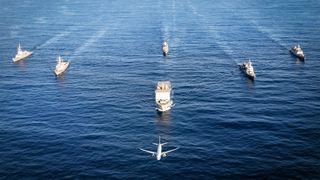While most analysts agree the Indo-Pacific is trending towards multipolarity, there is little consensus on the kinds of multipolar order that might emerge. An informed understanding of the likely configuration and nature of different Indo-Pacific futures is critical for Australia’s ability to make long-term security, defence, and international policy decisions.
A new research initiative by the United States Studies Centre (USSC) at the University of Sydney, Indo-Pacific strategic futures: Multipolarity, alignment dynamics and collective defence, examines how a range of regional powers are contributing and responding to an increasingly multipolar strategic environment in the Indo-Pacific, and how these trends might play out in coming years. It offers a variety of regional perspectives on current and future strategic challenges in the Indo-Pacific, including Japan, South Korea and the United States – three of Australia’s most important allies and partners.
In the first paper of this series, Multipolarity in the Indo-Pacific: Lessons for Australia from the past and present, USSC CEO Dr Michael J. Green, highlights lessons from earlier models of multipolarity from across the globe that Australia could harness to enhance its regional strategic literacy and agency in an increasingly multipolar environment.
“Accelerated defence cooperation in response to Chinese coercion is just one example of the opportunities for Australia in a multipolar region” Dr Green says. “While collective action between its partners – the United States and Japan – is opportunistic at present, Australia and its friends are gaining practice in new and more deliberate patterns of cooperation.”
Three expert-authored briefs then outline on the possibilities for South Korea, the United States and Japan presenting detailed predictions of how the region’s future balance of power will affect the dynamics of defence cooperation, alignment and deterrence through to 2040:
- USSC Non-Resident Fellow Dr Peter K. Lee considers the pivotal role that South Korea may play in the future of the Indo-Pacific. Read the brief: South Korean power in a multipolar Indo-Pacific
- Center for a New American Security Senior Fellow Becca Wasser argues that the end of US unipolarity has led to a new regional security architecture, but one that remains congruous with US interests and strategic objectives. Read the brief: Networked deterrence in a multipolar Indo-Pacific
- University of Sydney Associate Professor in International Security Dr Thomas Wilkins looks at Japan’s strategy to ensure that it remains a significant player in what it views as an increasingly multipolar regional security order. Read the brief: Japan and multipolarity in the Indo-Pacific: National mobilisation and resilience
"How states act on assumptions about polarity is no less important than the objective reality,” Dr Green concludes. “Understanding the trends in power distribution and how other states in the system are interpreting those trends has never been more important.”
Additional publications examining India’s perspective on collective defence in the Indo-Pacific and emerging nuclear polarity in Northeast Asia will soon follow.
Media enquiries
USSC Media
T 0468 480 165
E ussc.media@sydney.edu.au





